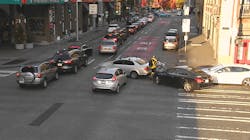SDOT and Seattle Police Department add three locations for additional cameras as part of automated enforcement pilot program
The Seattle Department of Transportation (SDOT) and Seattle Police Department have identified three locations for additional cameras as part of the automated enforcement pilot program evaluating cars illegally driving in bus-only lanes or blocking crosswalks and intersections. The new cameras will allow the city to collect a larger data set for a more robust analysis of the impact and effectiveness of these types of automated enforcement programs.
The city expects to install the cameras at the three identified locations at the beginning of September. There will be a 30-day warning period to ensure the public has adequate notice to learn the rules of the road.
A transit lane enforcement camera will be installed on the West Seattle Bridge (high bridge), just west of State Route 99, to monitor the bus lane to prevent drivers from illegally driving where they are not allowed.
Block the box enforcement cameras will be installed at Boren Avenue, Howell Street and the three-way intersection of Denny Way and Stewart Street and Yale Street to prevent drivers from driving on blocking crosswalks and intersections after the light turns red.
Cameras are already in place at the following locations:
- Aurora Avenue North at Galer Street (Transit Lane)
- 3rd Ave. at Stewart St. (Transit Lane)
- 5th Ave. at Olive Way (Transit Lane and Crosswalk and Intersection Blocking)
- 3rd Ave. at James St. (Transit Lane)
- 1st Ave. at Columbia St. (Transit Lane)
- 4th Ave. at Battery St. (Crosswalk and Intersection Blocking)
- 4th Ave. at Jackson St. (Crosswalk and Intersection Blocking)
- Westlake Avenue North at Valley Street/Roy Street (Crosswalk and Intersection Blocking)
All locations have clear signs and pavement markings, with white lines indicating where the intersection “box” begins, and road markings indicating lanes which are restricted to buses only.
The Washington State Legislature authorized the use of cameras to enforce bus lane and intersection violations in 2020.
SDOT installed signs in November 2021 to make sure drivers had time to learn the rules of the road and avoid receiving tickets.
Under state law, half of the net revenue from the traffic cameras will go to a Washington Traffic Safety Commission fund for bicycle, pedestrian and non-motorized safety projects, and the other half of the net revenue must be used to build safety and mobility improvements for people with disabilities in Seattle. SDOT plans to invest the money in building more accessible walk signals that vibrate and make a noise to let people with limited vision or hearing know when it is safe to cross the street.
To protect privacy, the cameras only record vehicle license plates and not the people inside the car. The photos are only intended to be used for enforcing the bus lane and blocking the box laws and are not intended for other law enforcement action.
